In web development, the Application object and Session object are both important components of server-side programming. While both objects are used to store data in memory, they have different scopes and lifetimes, and are designed for different purposes.
The Application object represents the entire web application and is shared by all users. It is created when the web application starts up and destroyed when the application is shut down. The Application object is typically used to store application-wide settings, such as database connections, configuration options, and other data that is shared by all users of the application.
The Session object, on the other hand, represents a user-specific session and is unique to each user. It is created when a user logs in to the web application and destroyed when the user logs out or the session times out. The Session object is typically used to store user-specific data, such as user preferences, shopping cart contents, and other data that is specific to each user.

Here are some of the key differences between the Application object and Session object:
Scope: The Application object has application-wide scope, while the Session object has user-specific scope.
Lifetime: The Application object has a longer lifetime than the Session object, as it is created when the web application starts up and destroyed when the application is shut down. The Session object has a shorter lifetime, as it is created when a user logs in and destroyed when the user logs out or the session times out.
Access: Both the Application object and Session object can be accessed from server-side code, such as ASP.NET or PHP, but only the Session object can be accessed from client-side code, such as JavaScript.
Concurrency: The Application object can be accessed by multiple users simultaneously, so it is important to use synchronization mechanisms to avoid data corruption. The Session object, on the other hand, is unique to each user, so there is no need to worry about concurrency issues.
In summary, the Application object and Session object are both used to store data in memory in web development, but they have different scopes and lifetimes. The Application object is used to store application-wide settings, while the Session object is used to store user-specific data. By understanding the differences between these two objects, web developers can choose the right object for the specific data they need to store.